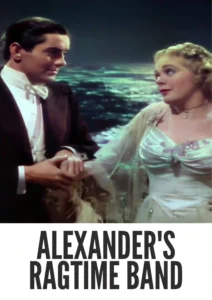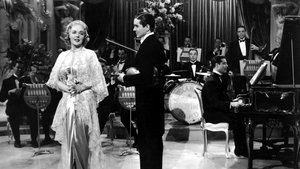Contact: [email protected]
Video Sources 0 Views
- Watch trailer
- Alexander's Ragtime Band


Synopsis
Table of Contents
ToggleReview: Alexander’s Ragtime Band (1938) – A Musical Extravaganza in Living Color

Introduction
“Alexander’s Ragtime Band” (1938) stands as a dazzling showcase of the Golden Age of Hollywood musicals, captivating audiences with its infectious melodies, dynamic performances, and vibrant visuals. In this review, we’ll explore the significance of this early colored film and its enduring legacy in the world of musical cinema.
Check The Full Colorized Movies List
Check Our Colorized Movies Trailer Channel
Understanding Alexander’s Ragtime Band: Director, Cast, and Genre
Directed by the legendary Henry King, “Alexander’s Ragtime Band” (1938) exemplifies the director’s mastery of storytelling and visual flair. The film boasts an ensemble cast of talented performers, including Tyrone Power, Alice Faye, and Don Ameche, whose electrifying performances bring the world of ragtime music to life on the silver screen. Blending elements of romance, drama, and musical spectacle, “Alexander’s Ragtime Band” (1938) transports viewers to a bygone era of jazz-age glamour and excitement.
Exploring the World of Alexander’s Ragtime Band: Plot and Characters
At its core, “Alexander’s Ragtime Band” (1938) follows the journey of a talented musician, portrayed by Tyrone Power, who rises to fame as the leader of a popular ragtime band. Along the way, he encounters a colorful array of characters, from aspiring singers to rival musicians, whose lives become intertwined in a whirlwind of passion and ambition. As the band’s popularity soars, they must navigate the challenges of fame, fortune, and forbidden love, testing the bonds of friendship and loyalty that unite them.
The Art of Film Colorization
Film colorization serves as a transformative tool that enhances the visual experience of classic movies, breathing new life into timeless stories and captivating audiences with vibrant hues. By digitally adding color to black and white films, colorization allows viewers to immerse themselves in the rich tapestry of cinematic worlds, exploring every nuance and detail with fresh eyes and renewed appreciation.
Early Colored Films: A Brief History
The history of colored films traces its roots back to the early days of cinema, with filmmakers experimenting with various techniques to add color to their creations. From hand-tinted frames to early Technicolor processes, the evolution of colored film has been marked by innovation and ingenuity, paving the way for the development of modern colorization techniques that continue to captivate audiences to this day.
Alexander’s Ragtime Band and Its Early Colored Version
The decision to release “Alexander’s Ragtime Band” (1938) in a colorized format was met with both excitement and trepidation. While some welcomed the opportunity to experience the film in vibrant color, others expressed concerns about the potential impact on its visual aesthetic. Nevertheless, the early colored version of “Alexander’s Ragtime Band” (1938) offers viewers a fresh perspective on the timeless tale of love and music, enhancing its emotional resonance and captivating audiences with its luminous beauty.
The Debate Over Film Colorization
The debate over film colorization continues to divide audiences and critics alike, with proponents praising its ability to breathe new life into classic movies and introduce them to a new generation of viewers, while detractors argue that it compromises the artistic integrity of the original work and diminishes its historical significance. As the debate rages on, filmmakers and audiences alike are left to ponder the merits and drawbacks of colorization in the ever-evolving landscape of cinema.
Examining Alexander’s Ragtime Band as an Early Colored Film
As with any colorized classic, the impact of colorization on “Alexander’s Ragtime Band” (1938) is a matter of personal interpretation. Some may argue that it enhances the film’s visual appeal and immerses viewers in its world, while others may feel that it detracts from the stark beauty of the original black and white version. Regardless of one’s stance on the issue, there’s no denying the enduring power of “Alexander’s Ragtime Band” (1938) as a timeless musical extravaganza that continues to capture the hearts of audiences around the world.
Influence and Legacy: Alexander’s Ragtime Band’s Impact on Cinema
“Alexander’s Ragtime Band” (1938) has left an indelible mark on the world of cinema, inspiring countless filmmakers and captivating audiences with its infectious melodies and dynamic performances. From its unforgettable songs to its breathtaking choreography, the film continues to resonate with viewers of all ages, reaffirming its status as a beloved classic of the musical genre.
Director’s Cinematic Legacy: Beyond Alexander’s Ragtime Band
Henry King’s influence extends far beyond “Alexander’s Ragtime Band” (1938), with a diverse body of work that continues to captivate audiences around the globe. From “The Song of Bernadette” to “Love Is a Many-Splendored Thing,” King’s films are celebrated for their emotional depth, compelling characters, and timeless themes, solidifying his legacy as one of the preeminent directors of Hollywood’s Golden Age. Through his groundbreaking work, King has left an indelible imprint on the world of cinema, inspiring generations of filmmakers to follow in his footsteps.
Themes Explored in Alexander’s Ragtime Band
“Alexander’s Ragtime Band” (1938) explores a myriad of themes, from the transformative power of music to the pursuit of dreams and the bonds of friendship and love. Through its vibrant characters and toe-tapping melodies, the film invites viewers to celebrate the joy of life and the universal language of music that transcends barriers of time and place. As audiences immerse themselves in the world of “Alexander’s Ragtime Band” (1938), they are reminded of the enduring power of music to uplift the human spirit and unite us in a shared sense of joy and wonder.
Reception and Controversy Surrounding Alexander’s Ragtime Band
Upon its release, “Alexander’s Ragtime Band” (1938) received widespread critical acclaim, with many praising its infectious melodies, dynamic performances, and vibrant visuals. However, the decision to release the film in a colorized format sparked debate among purists, reigniting the age-old discussion surrounding film preservation and artistic integrity. Despite the controversy, “Alexander’s Ragtime Band” (1938) remains a beloved classic that continues to captivate audiences with its timeless charm and unforgettable music.
Where to Watch Alexander’s Ragtime Band Online
For those eager to experience the timeless magic of “Alexander’s Ragtime Band” (1938), the film is readily available on popular streaming platforms such as Netflix, Amazon Prime, and Hulu. Whether you choose to watch it in its original black and white format or the early colored version, “Alexander’s Ragtime Band” (1938) promises to transport you to a world of music and romance, where dreams are born and legends are made.
FAQs About Alexander’s Ragtime Band
Q: Is “Alexander’s Ragtime Band” (1938) based on a true story? A: No, “Alexander’s Ragtime Band” (1938) is a fictional tale crafted by screenwriters Richard Sherman and Lamar Trotti, inspired by the music and spirit of the ragtime era.
Q: Who are the main actors in “Alexander’s Ragtime Band” (1938)? A: “Alexander’s Ragtime Band” (1938) features an ensemble cast led by the talented Tyrone Power, Alice Faye, and Don Ameche, whose dynamic performances bring the world of ragtime music to life on the silver screen.
Q: What awards did “Alexander’s Ragtime Band” (1938) win? A: “Alexander’s Ragtime Band” (1938) received three Academy Award nominations, including Best Picture, Best Original Story, and Best Original Score. Although it did not win any awards, the film remains a beloved classic of the musical genre.
Q: Why was “Alexander’s Ragtime Band” (1938) released in a colorized format? A: The decision to release “Alexander’s Ragtime Band” (1938) in color was made to introduce the film to a new generation of viewers and enhance its visual appeal for modern audiences. While the choice to colorize the film sparked debate among purists, it ultimately allowed “Alexander’s Ragtime Band” (1938) to reach a wider audience and ensure its continued relevance in the annals of cinematic history.
Conclusion
As we reflect on the enduring legacy of “Alexander’s Ragtime Band” (1938), let us celebrate its status as a timeless classic that continues to captivate audiences with its infectious melodies, dynamic performances, and vibrant visuals. Whether viewed in its original black and white format or the early colored version, “Alexander’s Ragtime Band” (1938) remains a shining example of the power of cinema to inspire, entertain, and uplift the human spirit.













